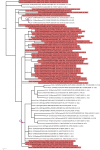Genomic epidemiology of SARS-CoV-2 in Russia reveals recurring cross-border transmission throughout 2020
- PMID: 37192187
- PMCID: PMC10187899
- DOI: 10.1371/journal.pone.0285664
Genomic epidemiology of SARS-CoV-2 in Russia reveals recurring cross-border transmission throughout 2020
Abstract
In 2020, SARS-CoV-2 has spread rapidly across the globe, with most nations failing to prevent or substantially delay its introduction. While many countries have imposed some limitations on trans-border passenger traffic, the effect of these measures on the global spread of COVID-19 strains remains unclear. Here, we report an analysis of 3206 whole-genome sequences of SARS-CoV-2 samples from 78 regions of Russia covering the period before the spread of variants of concern (between March and November 2020). We describe recurring imports of multiple COVID-19 strains into Russia throughout this period, giving rise to 457 uniquely Russian transmission lineages, as well as repeated cross-border transmissions of local circulating variants out of Russia. While the phylogenetically inferred rate of cross-border transmissions was somewhat reduced during the period of the most stringent border closure, it still remained high, with multiple inferred imports that each led to detectable spread within the country. These results indicate that partial border closure has had little effect on trans-border transmission of variants, which helps explain the rapid global spread of newly arising SARS-CoV-2 variants throughout the pandemic.
Copyright: © 2023 Matsvay et al. This is an open access article distributed under the terms of the Creative Commons Attribution License, which permits unrestricted use, distribution, and reproduction in any medium, provided the original author and source are credited.
Conflict of interest statement
The authors have declared that no competing interests exist.
Figures





References
-
- World Health Organization. Novel Coronavirus (2019-nCoV) SITUATION REPORT—1 2020.
-
- Interfax.ru. The head of Rospotrebnadzor named the date of the first case of coronavirus infection in Russia (in Russian) n.d. https://www.interfax.ru/russia/709883 (accessed September 1, 2022).
-
- Interfax.ru. The number of cases of coronavirus in Russia rose to 1836 (in Russian) n.d. https://www.interfax.ru/russia/701540 (accessed September 1, 2022).
-
- Coronavirus Graphs: Worldwide Cases and Deaths—Worldometer n.d. https://www.worldometers.info/coronavirus/worldwide-graphs/#total-cases (accessed September 1, 2022).
Publication types
MeSH terms
Supplementary concepts
LinkOut - more resources
Full Text Sources
Medical
Miscellaneous

